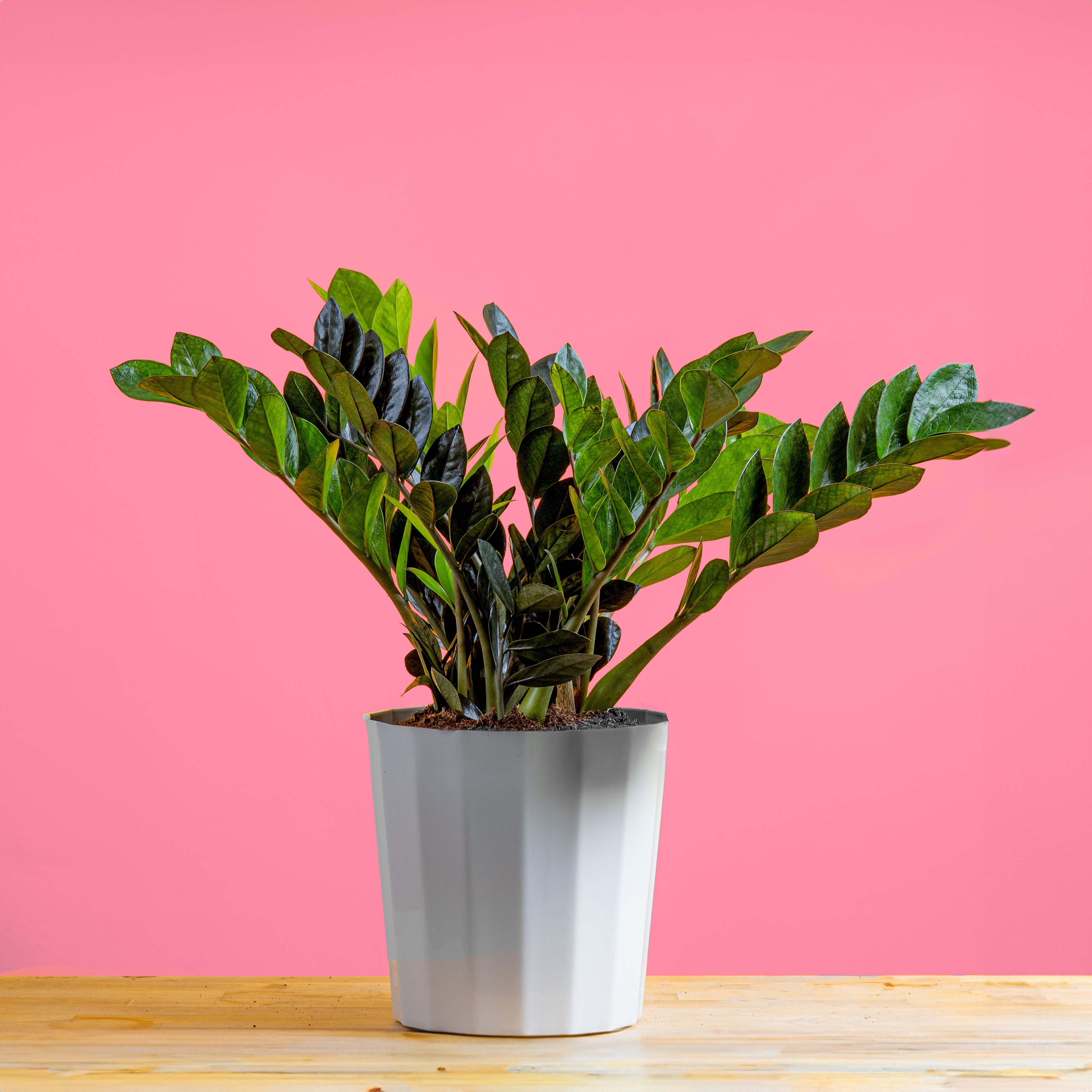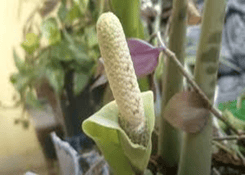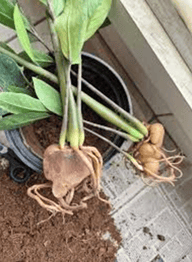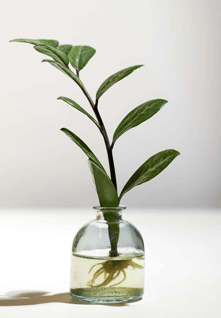ZZ Plant care, propagation, and general information about the plant.
Learn about how to water, what lighting level is best, when to fertilize, how to propagate, and general information about how the ZZ plant lives and grows.

How ZZ Plants Grow
- Leaf Growth:
New leaves emerge directly from thick, upright stalks that grow from the rhizome at the base of the plant. Each leaf unfurls slowly, with a glossy, waxy finish. - Growth Habit:
ZZ Plants grow in a clumping, upright form, with individual stalks rising from the underground rhizome. There’s no climbing or trailing—just clean, vertical growth. - Roots/Rhizome:
All roots grow below the soil from their potato-like rhizomes.
-png.png?width=156&height=139&name=image%20(1)-png.png)
A young ZZ plant with rooted rhizome and two new leaves
Key Characteristics: Leaves
- Each ‘stem’ of a ZZ Plant is really one compound leaf made up of multiple glossy, oval leaflets arranged in pairs along a central stalk. The leaflets are thick, waxy, and smooth, helping reduce water loss. New leaves emerge a lighter green, gradually maturing to a deep, shiny green depending on the variety.


One compound leaf of a ZZ plant.
Key Characteristics: Bloom/Inflorescence (Flower Structure)
- Spathe: A white, hood-like bract that resembles a petal. It starts out green and then often fades to green as it ages.
- Spadix: The central spike covered in tiny, tightly packed flowers.
- Flowers are rarely noticed due to location and size at the base of a leaf structure.


The inflorescence or bloom of a ZZ plant.
Key Characteristics: Rhizomes
- Plants grow from potato-like underground rhizomes that store water and nutrients.
- Rhizomes act as a built-in reservoir during dry periods.
- New stems grow directly from the rhizomes.
- Rhizomes multiply slowly, forming a dense underground network.
- Overwatering suffocates rhizomes and leads to rot.

The rhizomes of a ZZ plant.
Here’s what you need to know to keep ZZ Plants healthy and happy:
Light
ZZ Plants thrive in bright, indirect light, but they’re extremely tolerant of low light—one of the reasons they’re so popular.
They’ll grow more slowly in darker spaces, but they’ll survive if there is enough light to allow them to engage in photosynthesis.
Avoid intense, direct sunlight, which can cause leaf scorch.
Water
Let the soil dry out between waterings—ZZ Plants prefer to stay on the dry side.
Water when the top 2–3 inches of soil feel dry, or when the plant’s leaves start to wrinkle slightly.
Always ensure the pot has good drainage and never let the plant sit in water, as overwatering can lead to root rot.
Soil
Use a well-draining potting mix, ideally one designed for succulents or cacti with a little coir or peat added, or a general houseplant mix amended with perlite or sand. You can use a straight cactus or succulents mix but the plant will dry much faster.
ZZ Plants store moisture in their rhizomes, so the goal is to avoid soggy soil and promote fast drainage.
Fertilizer
ZZ Plants don’t need much feeding. Fertilize once a month during spring and summer using a balanced liquid fertilizer at half strength.
Skip fertilizing in fall and winter when growth naturally slows down.
Tips
- Dust the leaves with a damp cloth occasionally to help them absorb light and keep their glossy appearance.
- Yellowing leaves are often a sign of overwatering—check your soil moisture before reaching for the watering can.
- Leaf wrinkling or shriveling usually means the plant is too dry—give it a good drink and it should bounce back.
Propagation


Dividing rhizomes of a ZZ plant.
Propagation means creating a new plant from an existing one — essentially making a clone. Unlike philodendrons, ZZ Plants are most easily propagated by division, or more slowly, by stem or leaf cuttings that eventually form new rhizomes.
Best Time to Propagate:
Spring or early summer, when the plant is actively growing and can recover more easily from being divided.
Step-by-Step: How to Divide a ZZ Plant
- Remove the Plant from Its Pot
Gently slide the ZZ Plant out of its pot, taking care not to damage the thick rhizomes beneath the soil.
If it’s rootbound, carefully loosen the soil around the edges to free the plant.
2. Identify Natural Divisions Look for sections where the plant naturally separates into stalk clusters, each with its own rhizome and root system. Each division should include at least one healthy stalk, rhizome, and several roots.
3. Separate the Sections Use your hands to gently pull the rhizomes apart. If they’re tightly connected, use a clean, sharp knife to carefully cut them apart—avoid slicing through healthy roots whenever possible.
4. Repot Each Division Plant each section in its own pot filled with well-draining, potting mix. Position each division at the same depth it was growing before, and water lightly to help the roots settle in.
Aftercare
- Place the new divisions in bright, indirect light.
- Keep the soil slightly moist but never soggy—ZZ rhizomes are prone to rot if overwatered.
- Avoid fertilizing for the first month to reduce stress.
- Some yellowing or drooping is normal at first; the plant will perk up as it re-establishes its root system.

A rooted cutting of a ZZ Plant.
Optional Method:
ZZ Plants can also be propagated from individual stalks or leaflets placed in water or soil, but this process is very slow—it may take several months for new rhizomes and roots to form.
Water propagation
- Take a cutting:
Use a clean, sharp knife or scissors to cut a stalk just at the soil line.
- Prepare the cutting:
Remove the leaves from the bottom half of the stalk to prevent them from rotting in the water.
- Place in water:
Put the cutting in a clear glass with an inch or two of water, ensuring the cut end is submerged but the leaves stay above the water line.
- Provide light and care:
Place the glass in a spot with bright, indirect light and refresh the water as needed, especially if it becomes cloudy.
- Wait for roots:
Roots can take 3 to 4 months or longer to form. Once the roots are about 1 inch long, plant the cutting in soil.
Soil propagation
- Take a cutting:
Cut a healthy stalk from the plant, making sure to use clean tools.
- Plant in soil:
Place the cutting in a pot with well-draining potting mix. You can add rooting hormone or honey to the tip before planting to improve the chances of success.
- Provide light and care:
Place the pot in a location with bright, indirect light and water thoroughly. Continue to water only when the soil is dry.
- Wait for growth:
Be patient, as this method can take several months or even up to a year to see new growth emerge from the soil.

Rooted leaves from a ZZ plant.